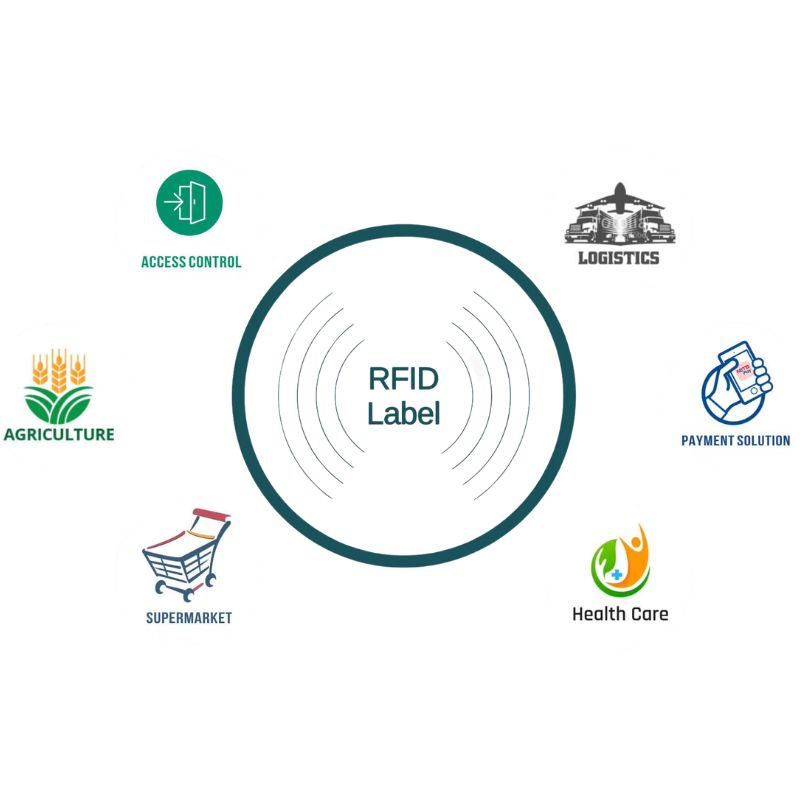
How does RFID Work in Warehouse Management?
Table of Contents
How RFID Transforms Warehouse Inventory Management
RFID (Radio Frequency Identification) is here—a powerful technology that’s revolutionizing warehouse management through real-time tracking, automation, and improved accuracy.
In this guide, you’ll learn:
- How RFID works in warehouse environments
- The key benefits vs. barcodes
- How to implement it successfully
- Real-world challenges and solutions
- Future trends in RFID + IoT for logistics

What Is RFID & How Does It Work in a Warehouse Management?
RFID is a wireless identification system that uses radio waves to track objects. Each item in your warehouse is equipped with an RFID tag, which transmits data to an RFID reader. That reader sends information to your warehouse management system (WMS), giving you real-time visibility into item location and movement.
Unlike barcodes, RFID tags don’t require line-of-sight, and multiple tags can be scanned simultaneously, even across packaging or pallets.
Want to choose the right tags for your setup? Explore our RFID tags for warehouse use.
Why Use RFID in Your Warehouse Management?
RFID goes beyond inventory control—it transforms operations.
Key Benefits:
- Real-time inventory tracking – Always know what’s in stock and where it is.
- Higher accuracy – Reduces human error during stock takes and picking.
- Increased efficiency – Read hundreds of tags in seconds.
- Lower labor costs – Automate tasks like scanning and data entry.
- Enhanced visibility – Integrate with ERP systems for full supply chain oversight.
“RFID automates what used to take hours of manual labor—giving businesses faster, smarter inventory control.”
How RFID Improves Inventory Accuracy
Manual processes are slow and error-prone. Barcode systems require scanning each tag individually, which often results in missed or misread items.
With RFID, inventory counts are automated and done almost instantly. Every RFID-tagged item updates the central database as it moves, enters, or exits the warehouse, eliminating discrepancies and preventing stockouts or overstocking.
RFID vs. Barcodes: What’s Better for Your Warehouse Management?
Both RFID and barcodes have their place in warehouse management, but RFID provides distinct advantages:
| Feature | RFID | Barcode |
|---|---|---|
| Line-of-Sight | Not required | Required |
| Simultaneous Scanning | Multiple tags at once | One item at a time |
| Durability | Tags are reusable and durable | Labels are prone to damage |
| Data Capacity | High | Limited |
While barcodes are cost-effective for smaller operations, RFID technology excels in environments requiring automation and scalability.
How to Implement RFID in Warehouse Management
Implementing RFID doesn’t have to be complex. Follow these key steps:
- Assess Your Needs – Identify bottlenecks RFID can solve (e.g., picking errors, slow stock counts).
- Select the Right Hardware – Choose the correct RFID tags and readers based on your product types and shelving.
- Map Reader Locations – Place readers at key zones: receiving, picking, staging, and shipping.
- Integrate with Software – Ensure your WMS can handle RFID data input/output.
- Train Your Team – RFID is user-friendly, but staff should understand the process and tools.
Tip: Start with a pilot area of your warehouse before full-scale rollout.
Cost Considerations for RFID Implementation
The cost to implement RFID depends on various factors, including the warehouse size, the type of tags and readers required, and the level of integration with existing systems. While initial costs may be higher than barcodes, the long-term savings from improved efficiency and reduced labor make RFID a worthwhile investment.
Challenges and Disadvantages of Using RFID
Despite its advantages, RFID comes with some challenges:
- Initial Cost: Setting up an RFID system can be expensive, particularly for small businesses.
- Interference: Radio waves can be affected by metals or liquids, impacting performance.
- Compatibility: Integrating RFID with existing systems may require additional investment.
Understanding these disadvantages of using RFID can help businesses prepare for a smoother implementation process.
RFID and Warehouse Automation
RFID is a cornerstone of modern warehouse automation. It enables:
- Automated check-in/out of goods
- Hands-free pallet scanning
- Automated alerts for low inventory or misplaced items
- Integration with robotics and IoT devices
Automation driven by RFID helps reduce manual labor, increase throughput, and optimize resource use.
Future Trends in RFID Technology for Warehouse Management
As technology advances, RFID is becoming more sophisticated. Emerging trends include:
- Integration with IoT: Connecting RFID systems with IoT devices for enhanced visibility.
- AI-driven Analytics: Using RFID data to predict demand and optimize stock levels.
- Sustainability: Development of eco-friendly RFID tags and solutions.
These advancements highlight the growing importance of RFID for inventory management in modern warehouses.

FAQs
How does RFID improve warehouse management?
RFID enhances efficiency by automating tracking processes, reducing human error, and providing real-time inventory data.
What are the costs associated with RFID implementation?
The costs vary depending on the size of the warehouse and the complexity of the system, but they include tags, readers, and software.
Can RFID replace barcodes in warehouses?
While RFID offers more advanced capabilities, barcodes remain a cost-effective solution for smaller operations.
What are the challenges of using RFID?
Common challenges include initial costs, potential interference, and system integration issues.
How can RFID help with supply chain management?
RFID improves supply chain visibility by providing accurate and real-time data, optimizing stock management, and enhancing traceability.
Ready to Upgrade Your Warehouse?
Explore our full range of:
RFID isn’t just a tech upgrade—it’s a game-changer for your bottom line.
Let us help you find the right setup for your warehouse. Contact us now
Comments
Hot Products

What Is RFID Waste Management
Imagine a city where every trash bin speaks — not literally — but through a tiny chip that tells the system when it’s full, when it’s emptied, and where it went. That’s what RFID waste management is doing today.

What are Bolt Seals and their Applications? | Complete Guide
In global trade and logistics, bolt seals play a crucial role in ensuring cargo security and compliance. These small but powerful devices are designed to lock shipping containers, trailers, and cargo doors with a tamper-evident mechanism.

What is an RFID Card Protector? Benefits, Use Cases, and Buying Guide
RFID technology (Radio Frequency Identification) is everywhere: in your credit cards, ID badges, transit passes, hotel room keys, and more. It offers speed and convenience, but it also opens the door to a new kind of digital theft called “skimming.” That’s where an RFID card protector comes in.

RFID Wristbands for Events: Bulk Buying Guide for Organizers
RFID wristbands for events are becoming the go-to solution for organizers who need faster entry, fraud prevention, and cashless payments at concerts, festivals, and sports venues. Unlike paper tickets or QR codes, these smart wristbands use embedded chips to streamline access, secure transactions, and improve the guest experience.

How RFID Tag on Windscreen Improves Vehicle Access Control and Toll Systems
In today’s fast-paced world, vehicle identification needs to be quick, secure, and contactless. An RFID Tag on the Windscreen provides exactly that — a reliable way to manage toll collection, parking, and gated access without stopping vehicles.

The Benefits of RFID Linen Tags in Commercial Laundry
Managing laundry in hospitals, hotels, or large laundry services is a big job. Each day, thousands of sheets, towels, and uniforms are washed, sorted, and sent back out. But problems like lost linens, sorting mistakes, and manual counting can cost companies a lot of money. For example, mid-sized hotels can lose over $200,000 each year from missing linens.
That’s where RFID Linen Tags come in.
Tags
RELATED BLOGS

What Is RFID Waste Management
Imagine a city where every trash bin speaks — not literally — but through a tiny chip that tells the system when it’s full, when it’s emptied, and where it went. That’s what RFID waste management is doing today.

What are Bolt Seals and their Applications? | Complete Guide
In global trade and logistics, bolt seals play a crucial role in ensuring cargo security and compliance. These small but powerful devices are designed to lock shipping containers, trailers, and cargo doors with a tamper-evident mechanism.

What is an RFID Card Protector? Benefits, Use Cases, and Buying Guide
RFID technology (Radio Frequency Identification) is everywhere: in your credit cards, ID badges, transit passes, hotel room keys, and more. It offers speed and convenience, but it also opens the door to a new kind of digital theft called “skimming.” That’s where an RFID card protector comes in.




